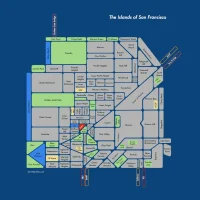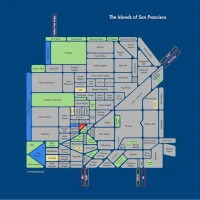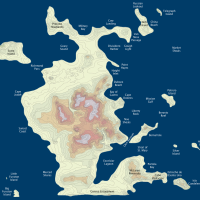What’s Underneath Those Brick Circles?
I’ll just start out by saying HOLY CRAP, because this is what you’re going to say when you realize what I’m about to show you.
You’ve probably seen these:
 by Cole Valley Alley (defunct)
by Cole Valley Alley (defunct)
All the way round:
I’ve always felt that a rite of passage in becoming a San Franciscan is discovering the true nature of these brick-lined circles. Streetcar roundabouts? No. Helipads! Nope. Crop circles gone horribly awry? Not quite. Cooling infrastructure for the Burrito Railgun? The SF Emergency IPA Supply? You’re getting closer.
They are SFFD water cisterns. They’ve been around since the city was founded (maps!), but were massively upgraded after 1906 as a backup system in an effort to keep the city from burning down after the next earthquake.
But did you ever wonder how big they are? I did, in a half-assed kind of way while passing by them. THEY ARE BIGGER THAN YOU THOUGHT:
This photo, taken by Robin Scheswohl, is badass in a number of ways:
Scheswohl has worked for the San Francisco Public Utilities Commission for six years photographing pump stations and reservoirs. She says this cistern was built in 1910, following the 1906 earthquake, as part of a supplemental source of water for the fire department. Scheswohl notes that, like the worker who was engaged in seismic upgrade work in the image, she wore a hazmat suit, a harness and an air quality monitor as part of her equipment to get the shot. The monitor was used to detect the presence of hydrogen sulfide gas.
Everything you wanted to know about San Francisco’s firefighting water supply is in this thorough article. In addition to the meaning of the different colored fire hydrants and redundant reservoir systems, we learn:
The average capacity of a cistern is 75,000 gallons with the smallest being 9,600 gallons, located at Stockton and Vallejo Streets, and the largest being 243,000 gallons, located in front of City Hall at the Civic Center.
For reference, Wolfram Alpha says 75,000 gallons would make a sphere about 27′ in diameter, or a cube 22′ on a side, so this looks to be a typical cistern.
Needless to say, Robin’s photo is one of the 2012 Engineering News-Record Images of the year, a worthy publication of various large and epic things. Some more shots:
Working above the fog on the new span of the Bay Bridge:
Some of the people digging the “New Irvington Tunnel“, an upgrade the water pipeline coming in from Hetch Hetchy.
It goes under the hills between Sunol Valley and Fremont and is a pretty big tunnel:
(If only we could make 3.5 mile transit tunnels in San Francisco for $319 million.)
Speaking of tunnels, did you know there’s already a second Transbay Tube? It’s 15 feet tall! Alas this particular Bay Tunnel will carry Hetch Hetchy water between Menlo Park and Newark.
More details on it and the whole upgrade project here. Yes, it uses a Tunnel Boring Machine.
The new pipe will be installed in a dedicated tunnel constructed roughly 100 feet below the bay floor. Known simply as the “Bay Tunnel,” the new conduit is 15 feet in diameter and more than five miles long. The digging is done by an earth pressure balance tunnel-boring machine (TBM), a type of tunneling system well suited to the dense clays that make up much of the bay floor. To launch the TBM, the project’s tunnel contractor, Michels/Jay Dee/Coluccio Joint Venture (MJC) excavated a shaft 58 feet in diameter and 124 feet deep in East Menlo Park on the west side of San Francisco Bay.
They just finished boring the tunnel itself and are installing the pipeline bit by bit.
The pipe installation will begin from the Peninsula shaft lowering the pipe spools, placing them on a carrier connected to a railroad car and delivering them through the tunnel to the Newark Shaft where the first segment will be installed. The end of each pipe spool will be fit and welded to connect and secure each joint. The Contractor expects to complete installing the pipe liner in early fall 2013.
So basically there are trains running underneath the Bay between Menlo Park and Fremont.
Here’s a photo of a piece of pipe being is lowered into the Crystal Springs bypass tunnel. (Photo via SPUR’s sobering “Future-Proof Water” report.)
And this conclude’s today’s summary of underground water infrastructure in the San Francisco Bay Area.
(Thanks to @spenbald for pointing out Robin Scheswoh’s cistern photo.)
Trackbacks
- Best Engineering Photography of 2012 Is Explosively Awesome | Musings of a Mild Mannered Man
- What’s Underneath Those Brick Circles?
- San Francisco’s Hidden World of Subterranean Cisterns | prettyawfulthings
- Cistern GIF | Burrito Justice
- Data Miner, Water Detective | Scott Kildall
- San Francisco’s Hidden Water Tanks – Hidden Hydrology
 by me
by me by Robin Scheswohl/SFPUC
by Robin Scheswohl/SFPUC by Martin Chandrawinata
by Martin Chandrawinata by Katherine Du Tiel/SFPUC
by Katherine Du Tiel/SFPUC by Katherine DuTiel/SFPUC
by Katherine DuTiel/SFPUC









IF ONLY there were passenger/commuter trains making that journey…
I’m always amazed there aren’t more incidences of collapsing cisterns, especially with all our minor earthquakes!
It looks like they are arched, so I’d imagine they are pretty strong.
I actually said “WHAT?!”
I KNOW
The trick to building a 3.5-mile tunnel for $319 million is to put it in the middle of nowhere.
Oh, my SF tunnels would just radiate out from La Lengua to various points in the city, so pretty affordable, really.
these photos are awesome
You’ve really outdone yourself here.
Are they all the same size, or is that one unusually large?
I believe they are all 75,000 gallons. Wolfram Alpha says that’s a sphere with a diameter of about 27 feet, or a cube 21 feet on a side, which looks about right.
It took me 21 years living here to finally learn what these were in the Cole Valley Alley. Very cool to see inside one of them.
When I first started looking for a house to buy in San Francisco, I toured one that was up somewhere above the Castro, maybe 17th Street, that had a cistern in it’s basement levels. It was a marvel — the huge tank surrounded by wood walkways and supports all sitting under the house on maybe 3 levels. The realtor said that the FD would maintain it, but it seemed a crazy thing to live with. I’ve always wondered what happened to that house and if the tank remains. I wish I could remember where it was exactly…
My whole life i wondered what the heck those brick circles were. I just assumed it was more something to do with the street cars than a water supply. Thanks for educating me on this obvious artifact that i have been seeing around town my whole life but never knew what it was. Is there a map showing where all of these are by the way?
Hehe, I would have guessed septic tanks.
Can I use this in SF Gate next week? It’s kind of amazing. Let me know- you will get all the credit- unless you want me to also credit someone else(?) Can’t tell from the photos if they are all yours or no. Thank you for another awesome post! Anna SF Gate and Curbed SF
________________________________
Hey Anna. No problem.
The top photo was taken by the now defunct Cole Valley Alley. The second photo is mine. All the rest are from the ENR photo of the year contest, except for the last one which is from SPUR.
Clicking on the photos will take you to the original sources.
(added inline text to clarify photo credits)